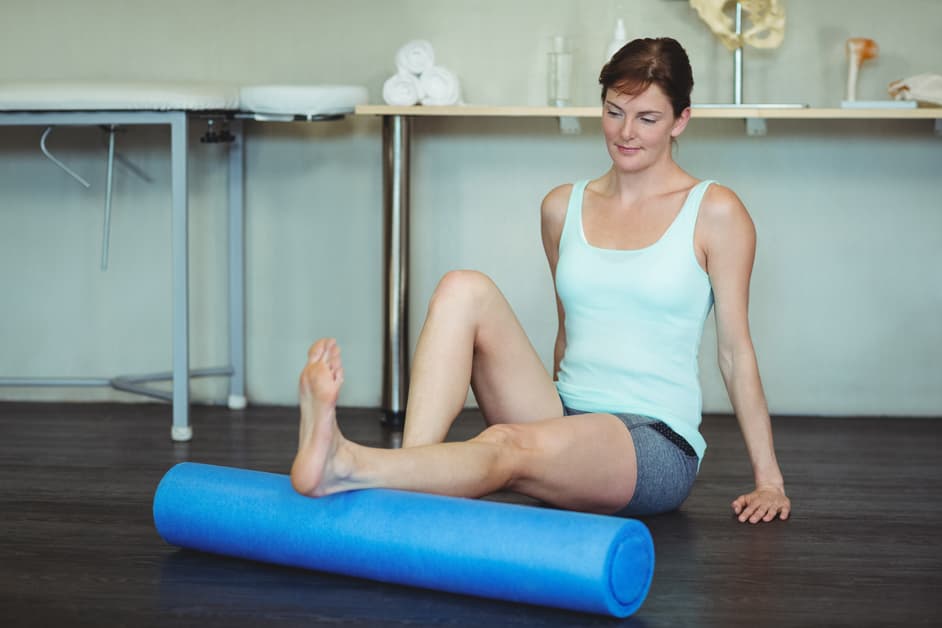Introduction
Foam rolling is becoming a hit among athletes and fitness fanatics, and it’s obvious why. Foam rolling is great for recovery and reducing inflammation. It’s a great way to manage knee pain due to overuse. In this article, we will explore the advantages of foam rolling and give you tips to make the most of it.
What is foam rolling?
Foam rolling is a self-myofascial release technique. It involves applying pressure to certain areas of the body to ease soreness and pain. It works by soothing muscle tension and knots in the fascia or tissue around muscles and joints.
Benefits include reducing body stress and aiding in proper functioning of muscles, joints, and nerve pathways. It can also help with overuse knee pain from intense workouts and long periods without rest.
Knowing the benefits, techniques, and safety measures of foam rolling for overuse knee pain relief can be more effective than stretching or massage.
Benefits of foam rolling
Foam rolling is an awesome way to boost your body’s wellbeing and performance. It’s especially good for those who have overuse injuries, such as knee pain. Foam rolling gives the same effects of a deep tissue massage. It helps reduce muscle tension, break up knots, and increase circulation. Athletes who use a foam roller often can help reduce the tension from old injuries or common use patterns. It can also improve range of motion by making tight areas more flexible.
When it comes to knee pain, foam rolling has some great advantages. Blood flow increases, which helps heal inflammation or strain on the joint or joint capsule. Muscles also become more relaxed due to decreased tension from poor posture or old injuries. Plus, it brings balance to opposing muscle groups that could be disrupted from regular movements like running or sitting. All of these benefits lead to better performance and less pain, making foam rolling an important tool for athletes with overuse knee injuries!
Overuse Knee Pain
Do you suffer from overuse knee pain? Athletes and active people often do. Foam rolling can help! You can do it at home or with an expert. Let’s explore what it is, the advantages, and techniques for using foam rolling to help with overuse knee pain.
Causes of overuse knee pain
Overuse knee pain can have many causes. Running, jumping, cycling, walking or climbing stairs too long can all lead to it. Kneeling or squatting while gardening, or playing sports with bad form can too. Ill-fitting shoes or high heels, and health conditions like arthritis can also cause it.
Imbalances in tissue tension from poor posture, combined with poor alignment in running and other physical activities, can also contribute. Tight muscles controlling pelvic rotation can cause the kneecap to track against the femur differently. This leads to extra stress on the joint, making it hard to manage load on activities involving your knee.
Symptoms of overuse knee pain
Knee pain caused by overuse is all too common. You may feel aching or tightness while walking, making it hard to do daily tasks. Other signs include:
- Pain when doing squats or lunges
- Pain that gets worse when running on inclines or going up stairs
- Sharp, sudden pain when running or jumping
- Knee stiffness in the morning that gets worse
- Swelling and redness around the joint
- Uncomfortable when performing normal activities.
Foam Rolling Techniques
Foam Rolling is gaining attention! It helps people relax tight muscles and be more flexible. Plus, it can help manage chronic knee pain from overuse. Let’s explore the foam rolling techniques to combat this type of pain.
Quadriceps foam rolling
Foam rolling your quadriceps can reduce overuse knee pain and increase mobility. This strengthens VMO (Vastus Medialis Obliquus), the medial part of the quadriceps muscle. Strengthening VMO helps to stabilize the knee, aiding recovery and managing the pain.
To foam roll your quads:
- Sit on a foam roller, with hips touching the ground and legs bent.
- Angle one knee at 45 degrees, with the foot flat on the floor. Place hands behind for support.
- Roll onto the thighs in slow, steady movements from above the knee to just below the hip joint. You should feel some soreness in 30 seconds – this is a sign of tension being released. Inhale as you move out, exhale as you move in, for 10-20 cycles. Then switch legs and repeat.
Foam rolling offers many advantages. These include:
- Improved circulation
- Reduced lactic acid
- Increased range of motion
- Myofacial release
- Decreased inflammation
- Improved posture
- Joint position sense
- Heightened awareness
- More muscular endurance
- Better performance
Hamstring foam rolling
Hamstring foam rolling is a great way to reduce tightness and pain. It’s like other forms of self-myofascial release or soft tissue mobilization. It can lessen tension in the hamstring muscles, making them less likely to strain or get injured.
To do it, start with a foam roller under the back of your thigh at mid-thigh level. Roll forward and back several times over the spot that feels tender or tight. Stay on it for 30 to 60 seconds, then move farther down the hamstrings and repeat. Cross-friction massage, going against the muscle fibers’ direction, can also help loosen the musculature and boost mobility.
Foam rolling has been used for centuries to treat myofascial pain and improve joint flexibility and range of motion, like knee osteoarthritis or runner’s knee pain. It may help healing by:
- Increasing oxygenated blood supply
- Breaking down fibrous adhesions
- Restoring muscles’ balance
- Reducing inflammation
- Easing muscle soreness after exercise
- Improving posture
- Relieving tension headaches caused by tight shoulder/neck muscles
So give it a try if your knees are hurting!
IT Band foam rolling
The iliotibial band (IT band) is a dense, fibrous band of tissue that runs from the hip to the knee. IT band syndrome is caused by tightness and stiffness in the structure, resulting in pain and difficulty with common activities like running.
Foam rolling is a great way to reduce IT band tension and overuse knee pain.
Begin by lying on the floor with one side against the foam roller. Apply pressure to the thigh above your outer hip bone. Roll up and down slowly. Avoid putting pressure on the bony part of your hip or any other sensitive areas.
Focus on any areas where you feel tension. Roll in the area between your hip bone and knee. Do 5-10 rolls up and down, then change direction and roll across the full width of the tension spot. Do this for 25-30 seconds, for a total session length of about 3 minutes.
Calf foam rolling
Calf foam rolling is a great way to reduce knee pain from overuse and provide temporary relief. Foam rolling can target muscles in the calves for better flexibility, circulation, balance and range of motion. It also gives a good massage to the muscles that stabilize your knees, helping to lessen the risk of injury.
Here’s how to give calf foam rolling a try:
- Position the foam roller under your calves.
- Roll up and down the muscles at a comfortable pace, 10 repetitions per side.
- Do each muscle group for 10 seconds to 2 minutes, depending on desired pressure. More pressure = more time.
- Increase intensity by rolling onto one side or targeting tight spots.
- Do each move gently. Too much force on sore or injured areas isn’t beneficial.
- At the end, stretch out the work done with the foam roller. This helps improve blood flow and healing.
Conclusion
Foam rolling is super for avoiding and managing knee pain. It’s a low-impact exercise that boosts mobility, blood flow, and loosens tense muscles. It’s essential to add foam rolling to your workout routine and do it routinely.
So, in conclusion: foam rolling is great for relieving pain and making the knee joint more flexible.
Summary of foam rolling benefits
Foam rolling is a self-myofascial release. It compresses body tissue, restoring and keeping muscles supple. It’s thought to ease tension and boost circulation, reducing inflammation.
Using foam rolling regularly can bring knee overuse pain relief. It can also increase joint range of motion, better mobility, decrease injury risk, and build muscle strength. Those who use it experience more pain relief than those who don’t.
Therefore, foam rolling should be part of your regular fitness routine for overall wellbeing.
Tips for foam rolling safely
Foam rolling is an awesome method to help ease overuse knee pain. But it’s important to remember some safety tips. Firstly, refrain from putting too much pressure, which may make the injury worse. Start with a lighter pressure and use your intuition to decide if you need more or less. Roll slowly to work the muscles and provide optimal release.
Be aware of any sharp jabs felt in the knee area. This might mean an active injury, not just a lingering one that needs myofascial release. Ease off until the intense feeling fades away. A softer tool, like a hand towel around the foam roller, may help to provide relief and require less weight from your body.
Combine foam rolling with other treatments and exercises for improved performance, mobility and to avoid injuries related to incorrect or no rest between workouts. Consult with your healthcare provider before beginning any treatment program for persistent knee pain, especially if none of the mentioned treatment options produce relief.
Frequently Asked Questions
Q: What are the benefits of foam rolling for overuse knee pain?
A: Foam rolling can help reduce overuse knee pain by increasing flexibility and mobility in the joint, as well as increasing blood flow and circulation to the area. This can help reduce inflammation and promote healing. Additionally, foam rolling can help reduce muscle tightness in the area which can help reduce pain.
Q: What techniques should I use when foam rolling for overuse knee pain?
A: When foam rolling for overuse knee pain, it is important to use slow and precise movements. Start by rolling the muscle groups around your knee and then move to the muscles of your hip and thigh. Spend about 30 seconds on each area for best results. Additionally, it is important to use the proper technique and to avoid rolling over bony areas or directly over the knee joint.
Q: How often should I foam roll for overuse knee pain?
A: Foam rolling for overuse knee pain should be done at least 3 – 4 times a week. This will help keep your muscles loose and promote healing. Additionally, it is important to listen to your body and take breaks when needed.





